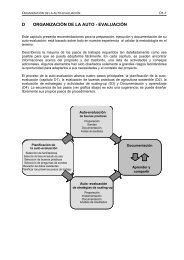cases from tanzania - Sustainet
cases from tanzania - Sustainet
cases from tanzania - Sustainet
Create successful ePaper yourself
Turn your PDF publications into a flip-book with our unique Google optimized e-Paper software.
5 Scaling up<br />
elected leaders, a set of rules, etc.), the particular form of the organization, its membership,<br />
focus and functions, and the rules it adopts, will vary <strong>from</strong> case to case.<br />
Means<br />
As implied in the list above, sustainable agriculture organizations use a wide range of techniques<br />
in functional scaling up. Here are some of them.<br />
• Training (e.g., of community AIDS educators)<br />
• Exposure tours for farmers to other farmer’s fields<br />
• Field days<br />
• Participatory evaluations to improve and adapt activities<br />
• Handouts to promote adoption of techniques<br />
• Focus discussions to improve or adapt technologies<br />
• Demonstrations of innovations and to suggest possibilities to adapt them<br />
• Farmer-to-farmer extension to exchange information<br />
• Creating new activities in response to participatory appraisal and evaluation.<br />
challenges<br />
Functional scaling up results in various challenges, some of them unique to this approach.<br />
• Organizational capability When adding or adapting activities, the development<br />
organization may find it lacks expertise in specific areas – a new crop, for example, or<br />
marketing or microfinance. It may have to develop its own skills in this area before it<br />
can be of use to farmers. Or it can ally with other organizations, as CHEMA (p. 77) did<br />
when teaming up with Matunda Mema, an export firm, to promote organic pineapple<br />
growing in Ihanda village in Tanzania. If required intervention is too far outside its own<br />
scope, it can refer it to other organizations (including the government) that are better<br />
equipped to intervene. Or, of course, it can choose to ignore the need.<br />
• Infrastructure and services Expanding the range of crops and products may be<br />
difficult without improvements in key infrastructure such as roads and electricity, and<br />
services such as veterinary services and organic certification. Similarly, the lack of key<br />
expertise market information and skills may make it hard to choose which new commodities<br />
are most appropriate.<br />
• Maintaining focus As an organization expands into unfamiliar new crops and products,<br />
it may find its efforts become too diluted. It risks losing its focus on the initial successful<br />
initiative, without a similar degree of success in the new ventures. The original farmers<br />
groups may still need support – and as their businesses develop, the type of support is<br />
likely to change.<br />
• Adapting approaches A new commodity may require a radically different approach to<br />
the one successfully used in the initial intervention. The organization may lack the vision<br />
to recognize this, or capability to adopt new, more appropriate methods. As a result, it<br />
may persist in trying to force square pegs into round holes.<br />
125




